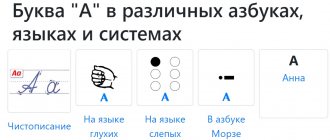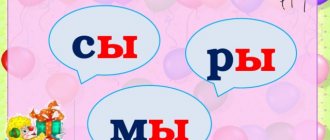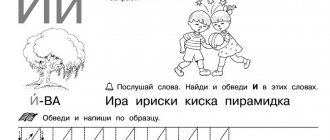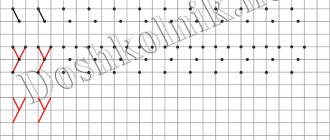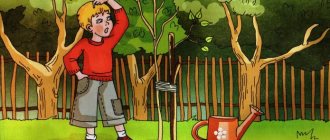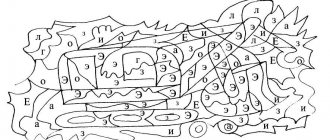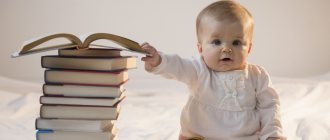Pelykh N.I., teacher-speech therapist, preschool educational institution No. 1410, Moscow
OBJECTIVES OF THE LESSON Comparison, discrimination and correct pronunciation of sounds [t] and [d] in syllables, words, phrases, stories. Development of logical thinking, attention, memory, phonemic hearing. Sound analysis and synthesis of one-syllable, two-syllable and three-syllable words based on the sound-syllable scheme of words and sentences. Distinguishing between paronymous words. Formation of polysyllabic words. Development of visual gnosis when composing a story based on supporting silhouette pictures using prefixed verbs. PREPARATION The following materials are prepared: - object pictures for the sounds [t] - [d]; - typesetting canvas; — flannelograph; - diagrams of words, sentences; - symbols of sounds; — plot pictures; - bear cub - bi-ba-bo toy; - screen. * * * Organizational moment There is a knock on the door. Speech therapist. Who's there? (Pulls out a bear cub from behind the screen.) Bear cub. It’s me, little bear, who came to visit you. Hello. Guys, did you receive my letter yesterday? Did you like my pictures? And today I have prepared riddles for you. The lanky man walked, got stuck in the damp ground. Largely, little by little, watered the whole earth with water. (Rain.) He bows, he bows, When he comes home he will stretch out. (Axe.) A white pillar stands on the roof And grows higher and higher, Now it has grown to the skies And disappeared. (Smoke.) Fluffy cotton wool floats somewhere. The lower the cotton wool, the closer the rain. (Cloud.) Children solve riddles. The little bear praises them and says goodbye. Comparison of sounds [t] - [d] Children sitting in the right row are asked to pronounce the sound [t], in the left - the sound [d], holding their hand on their throat. Speech therapist. How are the sounds similar? Children. The tongue knocks on the upper teeth, the lips smile, they are both consonant and firm. Speech therapist. What is the difference? Children. The sound [t] is deaf, and the sound [d] is voiced, we pronounce it with a voice. Differentiation of sounds [t] - [d] in syllables Didactic ball game “Say the other way around” Children are asked to stand in a circle. The task is given to come up with a syllable with the opposite sound. The speech therapist throws the ball to the child and pronounces the syllable “ta”; the child, returning the ball to the speech therapist, must say “yes” (“et” - “ed”, “you” - “dy”, etc.). Differentiation of sounds [t] – [d] in paronymous words Didactic game “Find a Pair” The typesetting canvas depicts a boy Tolya and a girl Dasha. Children are given the task of putting pictures with the sound [t] - Tole, and with the sound [d] - Dasha. The speech therapist pronounces sentences, and the children must name the last word that matches the meaning, find a picture and put it on the typesetting canvas. Speech therapist Let's call the book... (volume). We will build... (house) for housing. Here is a cart, this is... (wheelbarrow). The house in the garden is called... (dacha). They are floating along the river... (rafts). Ripening on the branches... (fruits). Etc. Sound analysis and synthesis of words Didactic exercise “Match the word to the diagram” Four schemes of words are depicted on the board, and on the children’s tables there are pictures depicting objects whose names contain the sounds [t] - [d]. Children are given the task of putting their pictures on the diagrams in accordance with the sound content of the word and explaining their choice. One-syllable words Smoke, shower, cat, house One-syllable words with a combination of consonants at the end Cake, tank, umbrella, bow Two-syllable words made of two open syllables Cotton wool, notes, melon, houses Three-syllable words made of open syllables Shovel, road, rainbow, car Physical education to the music, children pronounce a simple phrase and perform the corresponding movements. Children A woodpecker is hollowing out a tree, A woodpecker is hollowing out an oak tree with its beak. Knock-knock-knock, knock-knock-knock, he's looking for the worm here. Formation of polysyllabic words and development of phonemic hearing There are images of a girl and a cat on the flannelgraph. Speech therapist. What kind of hair does the girl have? Children. Blonde hair. Speech therapist. I lay out two stripes that indicate the number of words. Which girl? Say it in one word. Children. Blonde. In this case, on the flannelgraph, two short strips are combined into one long one. Speech therapist. What kind of ears does a cat have? Children. Short ears. Speech therapist. What cat? Say it in one word. Children. Short-eared. In parallel, children work with symbols. There are two cards on the tables: one empty (symbolizing a dull sound), and the other with the image of a bell (symbolizing a ringing sound). Children pick up one or the other card depending on what sound (voiced [d] or unvoiced [t]) they heard in the named words. Working on a sentence diagram One child lays out a sentence diagram on a flannelgraph, and the rest on the tables. A blonde girl plays with a short-eared cat. Differentiation of sounds [t] - [d] Story based on reference silhouette pictures “Tolya at the dacha” In the summer, Tolya rested at the dacha. He went to the river to catch fish with a fishing rod. Tolya got into the boat and sailed away from the shore. Sailed past the island. He swam across the river and swam to the other bank. He caught a lot of fish with his fishing rod and sailed home. Children retell the story first in a chain, and then in its entirety. At the end of the lesson, its conclusion is summed up. In order for a child to learn sound speech, the following conditions must be met. 1. First of all, the child’s speech apparatus must be in good working order; Each department must work correctly and in full harmony with the other departments. 2. The child must have good hearing. 3. Through this hearing he must perceive good examples of speech offered to him by those around him. 4. The child must be so mentally developed that he generally has something to talk about. 5. In the absence of at least one of these conditions, we are dealing with speech disorders or deficiencies.
Speech therapist's notes in 1st grade - Sounds [D] and [D`], letter D
Summary of a subgroup speech therapy lesson in 1st grade on overcoming speech disorders with students with a speech therapy conclusion “FFN in children with a dysarthric component”
Topic: “Sounds [D] and [D`]. Letter D."
Target:
Correctional: improve articulatory motor skills, sound pronunciation, consolidate acoustic-articulatory images of the sounds [D] and [D`], develop and consolidate the differentiation of soft and hard sounds, the connection of the sounds [D] and [D`] with the letter D, improve sound analysis skills and synthesis, letter and syllabic synthesis of words, reading comprehension, improve visual attention, spatial orientation;
Educational: clarify and consolidate ideas about sounds and letters, vowels and consonants, hard and soft consonant sounds.
Educational: cultivate mutual respect, mutual assistance, stimulate cognitive interest.
Equipment: computer, presentation for the lesson, colored chips for self-assessment.
Order the original presentation: This e-mail address is being protected from spambots. You need JavaScript enabled to view it.
All presentations here
Progress of the lesson:
Organizing time:
| The bell rang and class began. We sat down at our desks together and looked at me. |
Preparing educational supplies and workplace for class, proper seating.
Work on the topic of the lesson.
1. “Be careful!”
Slide 2.
- Look carefully at the images on the slide. - Count the number of soldiers on the right, and the number of tomatoes on the left. - Count how many houses there is smoke coming from the chimney.
Determine the common sound in the words: soldier, tomato, house.
2. Updating knowledge.
— What is the difference between sounds and letters? - What sounds are there? Name the vowel sounds and consonants. - What are the consonant sounds? Name the soft/hard consonant sound, voiced/voiceless.
Characteristics of sound [D], articulatory structure.
Slide 3.
- Describe the sound [D]. - How to pronounce this sound? — Does the sound [D] have a pair based on softness and hardness? - Describe the sound [D`]. - How to pronounce this sound?
3. Articulation gymnastics.
Slides 4-7.
Performed with individual mirrors:
- "sail";
- "woodpecker";
- “delicious jam”;
- "swing".
4. Determine which sound is [D] or [D`] in the name of the picture.
Slide 8.
The child names the picture and identifies the sound in the word.
5. Perform a sound analysis of words.
Slide 9.
Children analyze sequentially all the sounds in a word, establish their sequence and quantity, determine the number of vowels, stress and the number of syllables.
6. Form a word based on the first sounds of the names of the pictures.
Slide 10.
Children select the first sound from the names of the pictures, connect these sounds sequentially, and form a new word. They determine the presence of a sound [D] or [D`] in a word and give it a characteristic.
7. Letter D.
Slide 11.
The slide shows the printed letter D. The connection between sounds and the letter is updated. Children analyze it into its constituent elements. Compare it with similar objects.
D is a neat house with a high gable roof.
Slide 12.
Written letters are demonstrated: uppercase and lowercase. Children analyze letters into their constituent elements.
8. Finger gymnastics.
Slide 13.
The letter D is printed and written in the air with a finger. Writing the letter with the index finger on the palm of the opposite hand.
9. Find and count the number of letters D.
Slide 14.
Among letters with similar spellings, find and count the number of letters D.
10. Dynamic pause.
Slide 15.
When showing the image “tree” - children raise their arms up and wave them, “road” - walk in place, raising their knees high, “woodpecker” - swing with arms bent at the elbows. The images change chaotically. Children perform the movement in accordance with the picture. Determine which of the words - the names of pictures - has the sound [D], and which has the sound [D`].
11. Reading syllables and words with the letter D.
Slide 16.
12. Make a word from letters.
Slides 17 – 18.
From the letters given in a chaotic order, form words. Explain the meaning of the words. LIDA ⇒ LIDA BOAT ⇒ BOAT
13. Make a word from syllables.
Slides 19 – 21.
Compose words from syllables, establishing their sequence.
| COUNTRY HOUSE | PRUDY | ROAD |
14. The words “stuck together.”
Slide 22 - 24.
Read, set word boundaries. housegardenyear house garden year childrenmelon children melon smokedogday smoke dog day yardfriendcode yardfriend code
15. Find a match.
Slide 25.
After reading the words, children must choose a picture that makes sense. Kind ⇒ doctor, dear ⇒ gift, wild ⇒ dragon.
Summary of the lesson.
1. Generalization of knowledge.
Children name the sounds they worked with in class and give them characteristics. Associate sounds with letters.
2. Evaluate their work in class: choose a green circle for themselves (I understood everything, remembered everything, it was easy and interesting to study, helped others), yellow (it was difficult, I remembered everything, but needed help), red (it was difficult, boring, I I didn’t remember anything).
Author of the material: teacher - speech therapist MBOU "Secondary School No. 42" in Kurgan: Averina Lyudmila Vladimirovna
Also on topic:
Speech therapy lesson and presentation on the topic: “Sounds of d-t”
